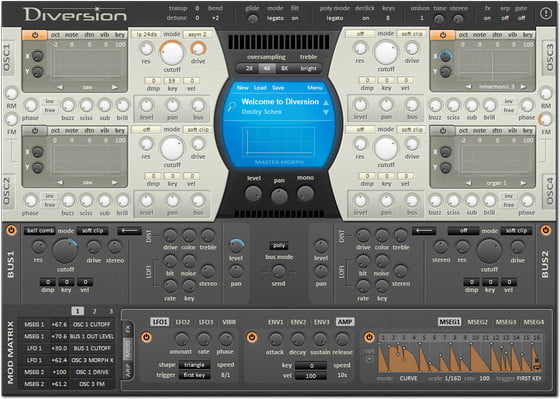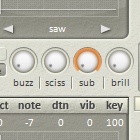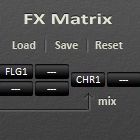Early 2010, Dmitry Sches released Ambient Voices, a soundset for the Zebra software synthesizer by u-he.
I was quite taken by Dmitry’s sounds, which I would describe as deep, rich, moving and edgy. Digital sweetness. With such a stunning debut I was kind of expecting there would be more soundsets in the near future, but… almost a year and a half passed without anything new. And then, I find Dmitry announcing something new over at KVR.
Hello! I’m Dmitry Sches and I proud to introduce new software synth – Diversion.
To be honest I didn’t even notice the first line in Dmitry’s announcement, as my eyes were all over the screenshot posted directly below it.
I know a good looking GUI doesn’t mean good sound, but a nice interface definitely helps spark my interest. Turns out the feature set is pretty impressive as well.
Diversion has 4 oscillators with waveforms that are done on the fly, in real-time. The idea here is that these generated waveforms (so not wavetables) allow for output with smooth two-dimensional morphing capabilities and clean high frequencies. Sure enough, Diversion sounds clean and crisp to my ears.
Various waveform shapes are available, grouped in basic, fatty, resonant, synthetic, harmonic and noise categories. The X/Y pad lets you play with the timbre of the sound source, usually with brightness and tone parameters (depending on the selected waveform).
Below the waveform selection are another four controls in which a selection from 7 oscillator effects can further modify the sound. Things like boosting high frequencies or creating aliased, inharmonic sounds can be achieved here. The effects go from subtle to rather dramatic.
Oscillators 1 and 3 have frequency and ring modulation controls, where the paired osc 2 and 4 are the modulating sources. A mono multi-mode filter with saturation stage and output section is also available for each oscillator.
Two bus sections take input from the oscillators and offer a stereo version of the filter found in the oscillator sections, distortion and lo-fi (bit crusher and decimator) effects. Each oscillator can route its output to either one or a mix of both bus processors.
Arriving at bottom panel we find a Mod Matrix with 4 sets of 6 modulation slots, and three tabs to switch between the FX Matrix, Modulation panel, and Arpeggiator.
Available effects include the usual things like delay, reverb, EQ, chorus, etc. and a special kind of pitch shift effect called GrainShifter. Two instances of each effect unit are available to route to up to 8 effects per fx line, with a separate fx line for each bus output. The point where both buses are mixed into a single signal (from which on effects are applied to the mixed output) can be changed. It’s a bit of an odd system at first but it works quite nicely and is flexible enough to create complex fx chains.
Diversion’s modulation system features 4 LFO’s, 4 envelopes, 4 MSEG’s (multi-segment envelopes), and the “Master Morph” X/Y controller (in the bottom of the middle blue screen). These can be assigned to parameters in the modulation matrix, or directly from the controls to be modulated. Quick and easy.
Finally, the 16-step trance gate and 32-step arpeggiator provide ways to create rhythmic and melodic sequences. Pretty straightforward stuff really. Not something I personally use a whole lot, but I always hear people appreciate these types of features so it’s nice to have a well-rounded set of arp and gate tools at your disposal.
The best way to experience Diversion is to give it a spin yourself. If you are short on time the official audio demo does a pretty good job showcasing its sounds and character.
Note that Diversion is currently available as a VST instrument plug-in for Windows only. Dmitry has recently announced that version 2.0 is in development for both Windows and Mac platforms. A release is expected late Fall, 2012.
So what do I think?
Format: VST for Windows
Price: $169 USD excl. VAT
Like: Crystal clean sounds, great workflow
Don’t like: Can get CPU intensive, price
Verdict: 9/10
Diversion is pretty amazing. It has a wonderful workflow and even though at first sight this is no ground-breaking synth, Dmitry has implemented a number of unique features that make Diversion stand out from the crowd. Most importantly though, this synthesizer offers a high quality sound, one I would describe as being pristine, clean and freshly edgy.
I think Dmitry’s heart for sound design shows in Diversion. The amount of control over the sound is impressive. A lot of sonic depth is provided with things like the oscillator tone-shaping section, multi-mode filters, and a comprehensive modulation system. The included presets showcase a lovely selection of bread & butter type modern day sounds.
Diversion has a lot to offer, but it comes at a cost: CPU. The manual includes some tips on how to reduce CPU usage – which is helpful, but personally I prefer to keep the CPU intensive sound and bounce it down rather than make changes to the sound in order to reduce CPU. Make sure to check the demo version to see how your system copes, especially since the plugin isn’t exactly cheap either.
In short, Diversion is an incredible feature-rich synthesizer with an outstanding sonic quality.
More information: Dmitry Sches / Diversion






